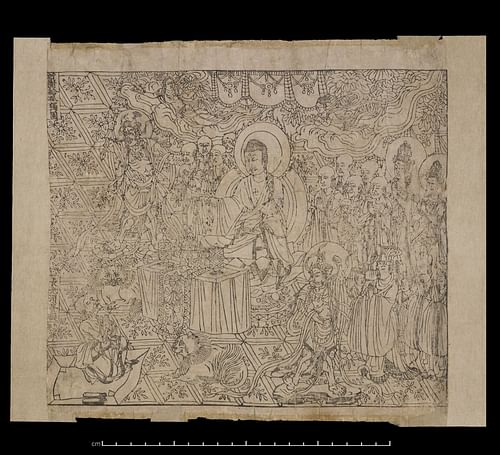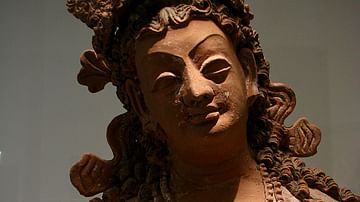
Perfection of Wisdom is the foundational text of the Mahayana Buddhist school, a kind of anthology of works, thematically linked, composed between c. 50 BCE - c. 600 CE in India by Mahayana Buddhist scribes. It is comprised of 38 sutras (defined, in Buddhism, as canonical scriptures) of over 100,000 lines.
The work is intended to guide a reader on the path to becoming a Bodhisattva (“essence of enlightenment”), the goal of the Mahayana school of Buddhism. The English title Perfection of Wisdom is a direct translation of the Sanskrit title Prajnaparamita.
The most famous works contained in Perfection of Wisdom are The Perfection of Wisdom in Eight Thousand Lines, the Diamond Sutra, and the Heart Sutra but the entire collection is honored highly and is utilized by Buddhists, of all different schools, worldwide, having been translated into many different languages over the centuries.
The text probably developed as a teaching tool but does not use conventional methods of instruction as its subject matter points away from such an understanding. The Buddha emphasized non-attachment to the world of the senses and so also to conventional means of recognizing the truth of existence. Accordingly, Perfection of Wisdom frequently relies on contradiction, self-contradiction, deconstruction of a concept, reconstruction of the same, and often purposefully confusing exchanges in order to jolt a reader out of expectation and prompt a new way of thinking and seeing.
Essentially, what Perfection of Wisdom is attempting is a kind of rewiring of a reader's mind to allow recognition of truths, which have always existed but were unable to be seen because of ignorance, attachment, and fear which result in spiritual blindness. The different sutras present dialogues between interlocutors, often the Buddha and a disciple or between Buddha's close followers, such as the sages Sariputra and Subhuti, discussing some aspect of perceived reality. The hoped-for result of these exchanges, much like the Greek philosopher Plato's dialogues, is to engage the reader fully in the discussion and encourage a significant change in one's perception and spiritual awareness.
Buddha's Vision & Path to Enlightenment
Siddhartha Gautama (the Buddha, l. c. 563 - c. 483 BCE) attained enlightenment upon realizing that the nature of life was essentially one and that this unity was defined by constant change. Nothing is permanent, he realized, everything is always in a state of flux, and people suffer in life through ignorance of this essential truth. People insist on holding onto relationships, to situations, to objects, and places as though these things will never change but, the Buddha realized, all things change, all the time, and by refusing to acknowledge and accept this, people not only spend their present lives in suffering but bind themselves further to the cycle of rebirth and death (samsara), ensuring they will experience the same level of suffering through multiple lifetimes.
Samsara was driven by a concept the Buddha called the Wheel of Becoming which he illustrated as a giant, ever-turning, spoked wheel with ignorance, craving, and aversion at its hub, the six states of existence between the hub and the rim, and the conditions of suffering along the rim. As long as one's understanding was governed by ignorance, craving, and aversion, one was bound to go round and round on this wheel, a slave to the conditions of suffering, and experiencing the six states of existence.
Only by recognizing the true nature of life could one be freed, and this “true nature” he recognized as interdependent arising (pratitya samutpada), defined by scholar John M. Koller as the full awareness that “everything is constantly changing, that nothing is permanent…that all existence is selfless, that nothing exists separately, by itself” (64).
The Buddha had freed himself from the wheel through ascetic discipline and deep meditation, finally dedicating himself fully to an understanding of the cause of, and release from, suffering which resulted in his enlightenment. He taught others that they could do the same through recognition of interdependent arising, acknowledging his Four Noble Truths (that suffering is caused by craving and suffering will end with an end to craving), and following the discipline of the Eightfold Path which leads one from ignorance and attachment to awareness and freedom.
After his death, his disciples established schools that continued his vision. One of the earliest of these was Mahasanghika (“Great Congregation”), a formative school of the Buddhist vision, which elevated the Buddha from a human being who, through his own efforts, had attained enlightenment, to a supramundane and transcendent entity who had always and would always exist. The Buddha, in spirit, was considered always present to guide the adherent on the path to becoming a Bodhisattva, one who had reached full awareness and chose to help others do the same and, in this way, the Buddha was one with his followers. This understanding of the Buddha's nature, his recognition of interdependent arising, and his path toward enlightenment informed the later school of Mahayana, which, like Mahasanghika, set the goal of the adherent as becoming a Bodhisattva. The Perfection of Wisdom texts were written to aid in this goal.
Perfection of Wisdom's Theme & Purpose
The 38 sutras of Perfection of Wisdom were written by different sages between c. 50 BCE - c. 600 CE with a focus on attaining the awareness of the Bodhisattva, a completely awakened individual, who is able to rightly instruct others in Buddhist Dharma (“cosmic law”) without the obstruction of ignorance or ego. In order to even begin on the path toward enlightenment, the adherent needed to fully recognize life as interdependent arising. One could not hope to do so, however, through conventional means of teaching because this method, of necessity, relies on conveying knowledge through reference to what is already known.
For example, if one were to teach another how to drive and care for a car, one might reference what the student already knows about riding and caring for a bicycle. In order to attain the enlightenment of the Bodhisattva, one had to realize that the car and bicycle were the same but, also, that there was no such thing as a “car” or a “bicycle” because both were part of the unity of existence just as the student was. A student might learn how to operate a motor vehicle through conventional teaching but in order to “know” what a car is, the totality of a car, one would need to step beyond conventional understanding to be able to see the car, not as an object to be mastered, but as a part of everything else, continually coming into being and passing away. Seen in this way, the operation and care for the car would appear less daunting to the student because, in essence, the student and the car are one and there is nothing to master.
In order to begin to move toward this step beyond clinging to what one thinks one knows, a new type of teaching method was necessary which would break one free of conventional thought and elevate the mind to a higher perspective from which one could clearly perceive the truth and discard the ignorance which previously clouded one's inner vision. Koller comments:
Because the fundamental insight of Buddhism is that the true nature of existence is that of interdependent arising, it sees the most basic ignorance as the lack of awareness of the true nature of existence as interdependent arising. But this ignorance is not merely lack of awareness; it is also the obscuring of the true nature of existence through the imposition of a false view on it. The false view is that existence – our own existence as well as the existence of other things – consists of permanent, separate beings. This false view prevents a person from seeing the truth of interdependent arising, from seeing that, in truth, existence is of the nature of ever-changing, totally interrelated processes. (67)
There is a significant obstacle to this recognition of interdependent arising as the nature of life, however: how one has been taught to understand and interpret existence. From the time one is young, one is brought up to recognize a dichotomy of me-and-you, of what-is-mine-and-what-is-not-mine, and, further, is encouraged to identify with a group – first family, then friends, a religious community, an occupation – which maintains and strengthens one's understanding of separateness through the us-and-them dichotomy which establishes “the other” as inferior, threatening, or both. One might eventually shed the misconception that one's community, in whatever form, is better than another's but will still retain the belief in separateness at the most basic level because that is how one has been taught to understand the nature of life. Perfection of Wisdom never “says” that one is wrong to understand the world in this way; it “shows” one that this understanding is not only wrong but a distortion of reality.
Perfection of Wisdom in Eight Thousand Lines
As long as one continues to think that one's understanding of the world is correct, there is no possibility of transformation because one does not see the need for change. Perfection of Wisdom attempts to force one to recognize this need through dialogues in which the interlocutors, all known to a Mahayana audience as enlightened individuals, seem to question the basic tenets of Buddhism, concepts of reality and, just as importantly, of seeming “logic” and “common sense”.
In the earliest text, The Perfection of Wisdom in Eight Thousand Lines (c. 50 BCE), two illustrious disciples of the Buddha, Sariputra and Subhuti, engage in just such a dialogue. Both men were recognized for their wisdom and high standing in the Buddhist community but, at various points, are presented as lacking understanding and in need of instruction. After a discussion which makes clear that there is no difference between a Bodhisattva and the Dharma of Buddhism, the conversation continues:
Sariputra: This thought which is no thought, is this something which is?
Subhuti: Is here existing, or can one apprehend, in this state of absence of thought, either a 'here is' or a 'here is not'?
Sariputra: No, not this.
Subhuti: Is this now a suitable question which the Venerable Sariputra asks whether this thought which is no thought is something which is?
Sariputra: So, what is this absence of thought?
Subhuti: It is without modification or discrimination. (I.2)
The conversation may at first appear to be nonsense, but this is exactly the point of Perfection of Wisdom: to force an audience to think beyond what has previously been defined as “nonsense” or “sense”. Sariputra asks whether a thought which is not a thought can exist. Instead of answering, Subhuti asks whether the place where they are conversing can even be said to exist. When Sariputra then asks what constitutes “absence of thought”, Subhuti replies that it is no different from thought. Absence of thought and thought are the same, just as “here” and “not here” are the same, because everything in existence is of the same transient substance, everything is one, and so absence of thought “is without modification or discrimination” from thought or from anything else.
Diamond Sutra
This method of instruction is continued in the Diamond Sutra (c. 2nd century CE, though later dates are given) and, most clearly, in Section 13 on How This Teaching Should Be Received and Retained:
At that time, Subhuti addressed Buddha, saying:
Word-honored One, by what name should this Discourse be known and how should we receive and retain it?
Buddha answered: Subhuti, this Discourse should be known as 'The Diamond of the Perfection of Transcendental Wisdom' – thus should you receive and retain it. Subhuti, what is the reason herein? According to the Buddha-teaching, the Perfection of Transcendental Wisdom is not really such. 'Perfection of Transcendental Wisdom' is just the name given to it. Subhuti, what do you think? Has [the Buddha] a teaching to enunciate?
Subhuti replied to Buddha: World-honored One, [the Buddha] has nothing to teach.
[Buddha said] Subhuti, what do you think? Would there be many molecules in the composition of three thousand galaxies of the worlds?
Subhuti said, Many, indeed, World-honored One!
[Buddha replied] Subhuti, I declare that all these molecules are not really such; they are called 'molecules' [and, further,] a world is not really a world; it is called 'a world'. (Baird & Heimbeck, 121-122)
This dialogue emphasizes the difference between what one calls something and what that thing actually is. In doing so, it negates the conventional understanding of definition and encourages a new way of understanding concepts such as “world” and “molecule” and even the Buddha's own teaching. When Subhuti replies that the Buddha has nothing to teach, he is saying that there is no differentiation between the Buddha's teaching, the Buddha, Subhuti himself, or anything else.
Heart Sutra
The Heart Sutra (c. 660 CE) is a later compilation and summary of the themes addressed by the earlier sutras. It is the most popular of the three addressed here because of the simplicity of its form and the skill with which the author condenses the themes of emptying-of-self and awareness of true reality. The Heart Sutra is regularly recited by Mahayana Buddhists and also ritually copied in order to impress the lessons on the mind of the adherent.
The focus of the Heart Sutra is emptiness: discarding the “self” one thinks one is as well as all the definitions and characterizations of the things of life in order to recognize the true nature of one's self and how the world operates. Koller comments:
The teaching of emptiness is designed to make clear that interdependent arising is primary; that it is the way that everything actually exists. Only when interdependence and change are seen as the very nature of existence, only when separate, independent, enduring things and persons are seen, from the perspective of emptiness, as mere conventions, abstracted from the reality of interdependent arising, is interdependent arising fully understood. (83)
The Heart Sutra drives this point home by continuing with the same kinds of dialogues as the earlier works with an emphasis on the experience of sunyata ("clear vision") which is necessary for one to attain the goal of becoming a Bodhisattva. In summarizing and simplifying the message of Perfection of Wisdom, the Heart Sutra completes the work and so lends itself to greater study, and generates a deeper devotion among adherents, than many of the other sutras.

Conclusion
This is not in any way to dismiss the value of the earlier works, all which point, in their own way, toward the same message as the Heart Sutra. Different adherents, and even different nations and Buddhist communities, often favor one sutra of Perfection of Wisdom over another. Although the three addressed here are, generally speaking, the most popular, another is The Perfection of Wisdom in One Letter which, as the title suggests, has only one letter in it – translated as the English letter 'A' which stands for the Sanskrit and Pali sound of the short a – and symbolizes both transformation and negation. Scholar Clark Strand explains:
Used as a prefix, it negates the meaning of the word which follows it – for instance, changing the word svabhava, "with essence", to asvabhava, "without essence". It is the first letter of all Indic alphabets and is often said to form the most neutral and basic sound of human speech. (1)
Concentrating on The Perfection of Wisdom in One Letter is thought to enlighten one to the unity of all things in that it dispenses with all preconceived notions of instruction or learning or even what constitutes a text. Through this work, one is brought face-to-face with actual reality in a single letter; encouraging the realization that the letter may seem to be a singularity, independent unto itself, but is both a beginning, a continuation, a negation, and part of a much larger vision than previously understood.








